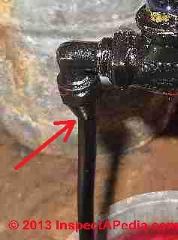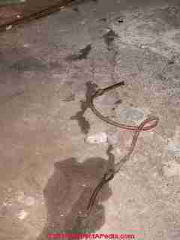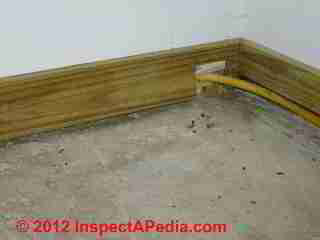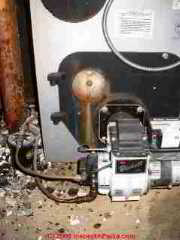 Causes of Oil Burner Feed Piping or Return Piping Heating Oil Leaks
Causes of Oil Burner Feed Piping or Return Piping Heating Oil Leaks
- POST a QUESTION or COMMENT about leaks or installation problems in heating oil piping for oil-fired heating equipment & water heaters
Causes of heating oil leaks in heating oil piping, fittings, at oil filters, and at oil burners:
This article describes the causes of leaks in oil burner piping - the supply and (where installed) return heating oil lines between the oil storage tank and the oil burner(s).
With exception of the portion of oil supply piping that may be buried beneath a floor, in a wall, or below ground, nearly always these oil line piping defects can easily be found by visual inspection.
InspectAPedia tolerates no conflicts of interest. We have no relationship with advertisers, products, or services discussed at this website.
- Daniel Friedman, Publisher/Editor/Author - See WHO ARE WE?
Sources of Leaks & Other Defects Found in Heating Oil Piping Between the Oil Tank & the Oil Burner
 Our photo at the top of this page shows the inlet end of the leaky oil safety valve discussed above. But I notice a second leak risk point in the photo: the heating oil line has been bent at a bit of an angle at its entry to the flare fitting cap (red arrow).
Our photo at the top of this page shows the inlet end of the leaky oil safety valve discussed above. But I notice a second leak risk point in the photo: the heating oil line has been bent at a bit of an angle at its entry to the flare fitting cap (red arrow).
While the seal of copper oil line flare fittings depends on the quality and fit of the actual flare pressing against the male surface of the flare fitting connector (not shown here), excessive bending back and forth of a poorly-routed oil line at the base of the flare fitting can crimp and eventually cut the copper line, leading to a leak in that location.
[Click to enlarge any image]
OIL LINE EXPOSED - Oil Line Exposed to Damage
Most leaks that occur in the copper piping used to carry heating oil between the oil storage tank and the oil burner occur due to
- Loose or improperly made flare fittings or other fittings
- Mechanical damage: an exposed heating oil line that has been stepped-on, bent, or kinked or otherwise exposed to mechanical damage, or on rare occasions, a nail or screw puncture of a hidden heating oil line.
A kinked oil line, or one that is actually punctured, means an indoor oil leak, possibly a catastrophic one, and earlier than that it risks air leaks into the heating oil system, improper operation, loss of heat, or a puffback.
Routing a heating oil delivery line, typically flexible copper tubing, across a basement or crawl space floor invites damage and leaks from people walking (or crawling) in the area. - Corrosion: corrosion due to contact of the copper heating oil tubing with a wet corrosive surface such as concrete or concrete block. Corrosion leaks in heating oil piping may be traced to
- Corroded oil piping fittings (threads exposed to greater corrosion than surrounding piping), or due to fittings of dissimilar materials (GALVANIC SCALE & METAL CORROSION)[3]
- Corroded heating oil piping, pitting of the tubing.[3] Pitting that is found in only a single section of continuous (one piece, no joints) oil piping is probably due to local conditions such as exposure to a spill, a corrosive material, or contact with a surface causing corrosion such as galvanic scale corrosion.
Pitting in copper oil lines that is found along the entire length of the piping, especially if the piping route includes both above and below ground or other varying contact surfaces, is more likely due to use of a lower grade material or material with manufacturing defects.

- Abandoned oil piping that has not been properly capped or sealed. Our photo at above left illustrates both exposed heating oil piping and water leaks at a basement floor.
Our photo shows how we often find "abandoned" UST oil tank piping - the technician cut off the underground oil tank supply and return lines at the building foundation wall.
Then s/he simply bent the oil line over and pounded it flat.
Actually this "abandonment" of an oil tank line may be fine if the oil tank piping was also cut off and removed at the outside of the foundation wall as well.
But if the outside tank and piping were left in place and not all was removed, this is another potential oil leak point.
How to Protect Heating Oil Flexible Copper Piping From Damage & Leaks
Check to see if the the oil lines are exposed atop the floor where they can be stepped-on. These flexible copper lines can be easily damaged, causing loss of heat or dangerous leaks.
But even running a heating oil line around the perimeter of a building has risks if the tubing is not protected.
For example running heating oil tubing where a finish floor baseboard or paneling are to be installed risks having the tubing punctured by someone driving a nail or drywall screw.
Our photo above shows steel nail plates protecting tubing from damage where it runs through wall studs. Protection plates, or nail plates are described and their use detailed in
- Simpson Strong-tie 2020 CODE-COMPLIANT REPAIR & PROTECTION GUIDE for the INSTALLATION of UTILITIES in WOOD FRAME CONSTRUCTION [PDF] (2020) Recommendations for the construction of building-code-compliant decks, Simpson Strong Tie®, retrieved 2020/11/23, original source: https://www2.strongtie.com/catalog_order.asp?site=SST where you can download any of a large collection of reference documents, catalogs, and product guides from Simpson Strong-Tie.
Where heating oil delivery piping or tubing runs through building walls or at the wall/floor juncture it should be protected from damage. [In a high risk area you can use black iron / steel piping (not commonly done).]
If in new construction the oil piping is run through the center of 2x4 or 2x6 wall studs, it's rather protected from drywalls screws or nails, but if the tubing is near the surface of the stud at either side (inside or the outside wall) it should be protected from nail punctures by using the same steel plates that are used to protect electrical wiring.
The heating oil piping lines should be protected by means approved by your heating service professional. This should be an inexpensive to correct unless you need to install a whole new oil line.
Our photo (above/left) shows the use of steel plates to protect an air conditioner condensate line (horizontal white plastic tubing at photo center) as well as the black insulated copper refrigerant tubing run in the building wall.
Do the same thing if oil piping lines are run in such a location.
Usually, however, we run heating oil delivery lines, flexible copper tubing, where it can be seen, and at the wall/floor juncture of a basement, crawl space, or garage, between the oil tank and the oil burner.
When we had the new flexible copper oil piping installed as shown in our photo, left, we opted for larger 1/2" ID tubing that was purchased including a heavy plastic protective jacket.
This coating helps protect the copper oil line from damage from being in contact with a concrete garage floor (abrasion, corrosion) and makes it a little more resistant to impact damage.
Photos above & below and left courtesy of Galow Homes.
But this copper piping could certainly be punctured should someone drive a nail through a floor/wall baseboard trim.
Therefore when the trim boards were being installed in this location (we used treated lumber because it's a garage exposed to water and snow-melt from vehicles), we insisted that the baseboard be held off the floor, and we personally drove each nail with great care to be dead certain that it was being driven several inches higher than the route of the oil piping that ran along the floor.
In our photo the left-side wall/floor baseboard trim covers the flexible copper heating oil tubing.
We stopped the drywall just above the tubing as well so that we could install the baseboard trim flush with the drywall.
But each nail was driven only in the top of the floor trim (red circles).
In the right side of the photo above you can see how we handled a corner turn for the tubing - we didn't want to install a 90 degree fitting, avoiding just one more place for a possible leak, and you can't bend this tubing at a sharp 90 so it had to come out from the wall a bit.
Keeping this oil line tubing in view also reduces the risk that some future renovator will be unaware that it is there.
The problem with a nail-punctured heating oil line is more likely to occur when the contractor installing baseboard trim along a floor is not someone who installed the copper oil supply line and does not even know it is there.
The risk is greater if the copper piping is hidden from view.
Watch out: DUAL HEATING FUEL OIL LINE Warning: improper installation of oil line shutoff valves can cause an oil line blow-out, big heating oil spill, even a big building fire
Do not install a second fusible-link fire safety valve (OSV) shutoff-valve on the return oil line. Use a check valve instead.
Details are
at DUAL OIL LINE 2 VALVES
OIL LINE SHUTOFF VALVE - missing or improper location
The proper location for the oil line shutoff valve with a fusible link (Fire-o-Matic™ type valves) is just before the oil filter and close to each individual oil burner.
Details about oil line shutoff valve and oil line safety valve installation and operation are
at OIL SUPPLY LINE SAFETY VALVES, OSVs
Frequency of Occurrence of Heating Oil Piping Leaks
Reader Question: How frequently do the copper oil lines leak from corrosion or other factors?
Contractor renovating my basement enclosed the fuel oil line (tank to burner) in the walls. Just after having carpet laid, I was reinstalling baseboards and my nail gun made a perfect nail hole in the hidden piping. About 2 qts. oil all sprayed out. I shut off tank valve and ran furnace to use up oil in lines. It will be a massive clean-up and I don't want to have this happen again.
How frequently do the copper lines leak from corrosion or other factors? What are the options to prevent a future leak? - Judy 4/23/12
Reply: Frequency of Heating Oil Piping Leaks by Leak Location, Type, Source, Cause
Judy, statistics on oil tank leaks are discussed
While those data focus on and report leaks as oil tank leaks, actually some of the leaks reported under the aegis of "oil tanks" may actually occur in the oil supply and return piping (on a two pipe system for buried tanks) or on the oil supply line from an above-ground oil tank.
But I have not found studies, reports, nor statistics on the leak occurrence rate in just heating oil piping itself. In my experience, small leaks in the oil piping system are not uncommon. But as leaks in the supply line lead to faulty oil burner operation, ultimately they lead to a diagnosis and repair.
(See the previous Q&A about vacuum tests and pressure tests on oil heat piping and on fuel units respectively.)
Oil Piping Leak Report of 0.005 in New England
At OIL TANK LEAK / FAILURE RATES we include a section on reports of frequency of heating oil piping leaks. You will see that studies found the leakage rate in New England in the U.S. at about five leaks per thousand customers or less, depending on the sub-area in the study.
Oil Tank Leak Report of 40% with 82% due to Oil Piping in Maryland
In a 1986 study Diane H. Heck found leaks in 40% of petroleum fuel tanks (diesel fuel or kerosene K-1, heating oil, waste oil, and gasoline tanks), (n=240). More accurately she reported a 40% leak occurrence rate in oil storage tank installations, because 82% of those leaks were traced to leaks in oil piping![3]
Because gasoline tanks were included in this study, several factors may lead readers to think that a higher proportion of leaks occurred in gasoline storage tanks than in heating oil or kerosene storage tanks.
But as we report at OIL TANK LEAK / FAILURE CAUSES that was not the case. Gasoline tanks were responsible for only 26% of all of the leaks found.
Opinion about Probable Percentage of Types of Oil Piping Leaks
My opinion based on field experience repairing heating systems and on field experience as a building inspector of several thousand buildings is that among the leaks that do occur in oil piping systems, they occur in roughly this frequency by type:
- Leaks in oil piping due to a loose, or a poorly-made connection or joint - 80% OR MORE
- Leaks in oil piping due to mechanical damage such as being stepped-on or bent repeatedly or due to a combination of vibration & contact with an abrasive surface - 15 %
- Leaks in oil piping due to abrasion or corrosion leading to a thinning of and ultimately perforation of the piping wall - 5%
- Leaks due to perforation by a nail or screw during construction - less than 1%.
This is because most often the heating oil piping is exposed along a garage or utility area floor or ceiling and is not buried in walls. Certainly if an oil line were to be installed running hidden inside a wall or floor I'd be nervous about including any fittings whatsoever, as it is at the fittings that the leak risk is greater.
See HEATING SYSTEM BUZZING NOISE
In the article above on this page at section titled Defects Found in Heating Oil Piping Between the Oil Tank & the Oil Burner, we catalog the types of leaks that occur in oil piping and where they are found. We also describe steps that can be taken t protect oil piping lines from future damage, including a nail puncture such as your oil piping line suffered.
In the Technical Reviewers & References section of this article we include additional citations on oil piping leak detection & frequency.
...
Continue reading at OIL SUPPLY LINE VACUUM-ACTIVATED OSVs & PRVs valves to prevent oil line leaks, or select a topic from the closely-related articles below, or see the complete ARTICLE INDEX.
Or see these
Recommended Articles
- OIL LINE PIPING - home
- OIL LINE AIR REMOVAL PROCEDURE
- OIL LINE BUZZ & VIBRATION CURE
- OIL SUPPLY & RETURN LINE CONTROLS & VALVES
- OIL SUPPLY LINE CHECK VALVES
- OIL LINE CLOGGING FIX
- OIL SUPPLY & RETURN LINE DE-AERATORS Tigerloop™
- OIL SUPPLY LINE PIPING LEAKS
- OIL LINE PIPING LEAK CAUSES
- OIL LINE QUICK STOP VALVES
- OIL SUPPLY LINE SAFETY VALVES, OSVs
- OIL SUPPLY LINE SAFETY VALVE TURN DIRECTION to OPEN or SHUT
- OIL LINE VACUUM & PRESSURE TESTS
- OIL SUPPLY LINE VACUUM-ACTIVATED OSVs & PRVs
- OIL or GAS FUELED HEATING EQUIPMENT SHUTOFFS
- OIL SPILL CLEANUP / PREVENTION
- OIL TANK PIPING & PIPING DEFECTS - home
Suggested citation for this web page
OIL LINE PIPING LEAK CAUSES at InspectApedia.com - online encyclopedia of building & environmental inspection, testing, diagnosis, repair, & problem prevention advice.
Or see this
INDEX to RELATED ARTICLES: ARTICLE INDEX to HEATING OIL, OIL BURNERS, OIL FIRED HEATERS, OIL TANKS
Or use the SEARCH BOX found below to Ask a Question or Search InspectApedia
Ask a Question or Search InspectApedia
Try the search box just below, or if you prefer, post a question or comment in the Comments box below and we will respond promptly.
Search the InspectApedia website
Note: appearance of your Comment below may be delayed: if your comment contains an image, photograph, web link, or text that looks to the software as if it might be a web link, your posting will appear after it has been approved by a moderator. Apologies for the delay.
Only one image can be added per comment but you can post as many comments, and therefore images, as you like.
You will not receive a notification when a response to your question has been posted.
Please bookmark this page to make it easy for you to check back for our response.
IF above you see "Comment Form is loading comments..." then COMMENT BOX - countable.ca / bawkbox.com IS NOT WORKING.
In any case you are welcome to send an email directly to us at InspectApedia.com at editor@inspectApedia.com
We'll reply to you directly. Please help us help you by noting, in your email, the URL of the InspectApedia page where you wanted to comment.
Citations & References
In addition to any citations in the article above, a full list is available on request.
- [1] "Fuel Oil Piping and Storage", 2006 Mechanical Code, Chapter 13, International Code Council, 500 New Jersey Avenue, NW, 6th Floor, Washington, DC 20001, Tel: 888-ICC-SAFE (422-7233); Website: iccsafe.org/, Email: webmaster@iccsafe.org, Customer Store (buy publications) 800-786-4452. Also see 2009 International Codes and 2012 International Codes.
- [2] "The application of a continuous leak detection system to pipelines and associated equipment", Sandberg, C.
Raychem Corp., Menlo Park, CA, Holmes, J. ; McCoy, K. ; Koppitsch, H, Industry Applications, IEEE Transactions on, Sep/Oct 1989, Vol. 25 No. 5, pp. 906-909, ISSN : 0093-9994 INSPEC Accession Number: 3582593 Digital Object Identifier : 10.1109/28.41257, Abstract:
An overview of classical leak detection systems is given and the engineering basis of a novel type of detector is examined. This system is a flexible hydrocarbon-sensing cable that can be installed along pipelines, in double-containment tanks and piping, or in trenches to detect and locate leaks of common industrial hydrocarbon solvents or fuels while ignoring the presence of water. The simple electrical circuit that locates and detects a leak anywhere along the length of the sensor is also described - [3] "A Case Study of a Large Scale Precision [oil or fuel] Tank Testing Program", Diane H. Heck, Tetra Tech Richardson, Newark, Delaware, web search 4/27/12, original source: info.ngwa.org/GWOL/pdf/870143411.PDF, copy on file as /heating/OIl Tanks UST/Tank_Test_Heck_870143411.pdf
- Our recommended books about building & mechanical systems design, inspection, problem diagnosis, and repair, and about indoor environment and IAQ testing, diagnosis, and cleanup are at the InspectAPedia Bookstore. Also see our Book Reviews - InspectAPedia.
- In addition to citations & references found in this article, see the research citations given at the end of the related articles found at our suggested
CONTINUE READING or RECOMMENDED ARTICLES.
- Carson, Dunlop & Associates Ltd., 120 Carlton Street Suite 407, Toronto ON M5A 4K2. Tel: (416) 964-9415 1-800-268-7070 Email: info@carsondunlop.com. Alan Carson is a past president of ASHI, the American Society of Home Inspectors.
Thanks to Alan Carson and Bob Dunlop, for permission for InspectAPedia to use text excerpts from The HOME REFERENCE BOOK - the Encyclopedia of Homes and to use illustrations from The ILLUSTRATED HOME .
Carson Dunlop Associates provides extensive home inspection education and report writing material. In gratitude we provide links to tsome Carson Dunlop Associates products and services.





